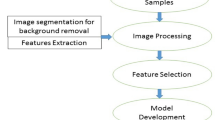Abstract
For the traditional machine learning methods rely on manual experience and deep learning classification model depth and complex structure, resulting in poor gangue classification performance, this paper proposes a coal gangue recognition method (CNN-SVM) based on the combination of convolutional neural network (CNN) and support vector machine (SVM). Firstly, we use a generative adversarial network (DCGAN) to generate new coal gangue samples and expand the gangue dataset by traditional image enhancement techniques to increase the data samples and improve the generalization of the model; then we construct an efficient and simple CNN as a coal gangue feature extractor and verify the effect of convolutional kernel size on the accuracy of the model, and determine the 5\(\times\)5 size of the convolutional kernel to extract more accurate and comprehensive coal gangue; Finally, it is combined with SVM using grid optimization to improve the accuracy of coal gangue recognition. The experimental results show that the recognition accuracy of the constructed model reaches 97.5\(\%\), which has obvious advantages compared with traditional classification models and classical classification models, and the recognition speed is faster compared with the mainstream classification models, which provides a new idea for coal gangue recognition.








Similar content being viewed by others
Data availability
Due to the nature of this research, participants of this study did not agree for their data to be shared publicly, so supporting data is not available.
References
Zhang, J.C.: Analysis of the development status of coal beneficiation technology and its impact on the clean utilization of coal. Min. Equip. 05, 32–33 (2018)
Cao, X.G., Li, Y., Wang, P., et al.: Research status and prospect of coal gangue identification method. Ind. Min. Autom. 46(01), 38–43 (2020)
Pang, S.Z., Li, B., Wang, X.W., et al.: Design and experimental study of coal gangue identification system based on machine vision. Coal Eng. 53(02), 141–146 (2021)
Wang, J.C., Li, L.H., Yang, S.L., et al.: Experimental study on grayscale and texture feature iextraction of coal gangue images under different illumination levels. J. Coal 43(11), 3051–3061 (2018)
Tian, D.Y., Ding, S.F., Guo, X.G.: Image processing based coal gangue identification method. Coal Technol. 41(03), 201–204 (2022)
Xue, G.F., Li, X.Y., Qian, H.L., et al.: Random forest-based image recognition of coal gangue at heaving workface. Ind. Min. Autom. 46(05), 57–62 (2020)
Dou, D., Wu, W., Yang, J., et al.: Classification of coal and gangue under multiple surface conditions via machine vision and relief-SVM. Powder Technol. 356, 1024–1028 (2019)
Gao, Y.S., Zhang, B.Q., Lang, L.Y.: Deep learning based coal gangue identification technology and implementation. Coal Sci. Technol. 49(12), 202–208 (2021)
Cao, X.G., Xue, Z.Y.: Migration learning based GoogLenet coal gangue image recognition. Software Guide 18(12), 183–186 (2019)
Pu, Y., Apel, D.B., Szmigiel, A., et al.: Image recognition of coal and coal gangue using a convolutional neural network and transfer learning. Energies 12(9), 1735 (2019)
Radford A, Metz L, Chintala S. Unsupervised representation learning with deep convolutional generative adversarial networks. arXiv preprint arXiv:1511.06434, 2015
Goodfellow, I.J., Pouget-Abadie, J., Mirza, M., et al.: Generative adversarial networks. Adv. Neural. Inf. Process. Syst. 3, 2672–2680 (2014)
Xu, B., Wang, N., Chen, T., et al.: Empirical evaluation of rectified activations in convolutional network.2015, arXiv preprint arXiv:1505.00853
Krizhevsky, A., Sutskever, I., Hinton, G.E.: ImageNet classification with deep convolutional neural networks. proceedings of the 25th International Conference on Neural Information Processing Systems. Red Hook, NY:Curran Associates Inc, 2012:1097–1105
Cortes, C., Vapnik, V.: Support-vector networks. Mach. Learn. 20, 273–297 (1995)
Simonyan, K., Zisserman, A.: Very deep convolutional networks for large-scale image recognition. Computer Vision and Pattern Recognition recognition. Proceedings of the IEEE conference on computer vision and pattern recognition. 2016, 770–778 (2014)
He, K., Zhang, X., Ren, S., et al.: Deep residual learning for image recognition. Proceedings of the IEEE Conference on Computer Vision and Pattern Recognition 770–778 (2016)
Howard, A., Sandler, M., Chu, G., et al.: Searching for mobilenetv3. Proceedings of the IEEE/CVF international conference on computer vision. 2019: 1314–1324
Ma, N., Zhang, X., Zheng, H.T., et al.: Shufflenet v2: Practical guidelines for efficient cnn architecture design. Proceedings of the European conference on computer vision (ECCV). 2018: 116–131
Dosovitskiy, A., Beyer, L., Kolesnikov, A., et al.: An image is worth 16x16 words: Transformers for image recognition at scale. arXiv preprint arXiv:2010.11929. (2020)
Liu, Z., Mao, H., Wu, C.Y., et al.: A convnet for the. Proceedings of the IEEE/CVF Conference on Computer Vision and Pattern Recognition. 2022, 11976–11986 (2020)
Acknowledgements
This research was funded by the Foundation of the National Key R &D Plan Project of China (2018YFC0604502). We wish to express our sincere thanks to thank the anonymous reviewers for their valuable suggestions and comments regarding this paper on this paper. We would also like to moreover, we thank the author who provided the reference code for this article.
Author information
Authors and Affiliations
Contributions
RG: Conceptualization, funding acquisition, writing review and editing; YD: methodology, software, validation, formal analysis, writing original draft preparation; TW: methodology, software, validation, formal analysis, data curation, writing original draft preparation.
Corresponding author
Ethics declarations
Conflict of interest
The authors declare that they have no known competing financial interests or personal relationships that could have appeared to influence the work reported in this paper.
Ethical and informed consent
There are no moral or ethical issues with the papers written by the authors.
Additional information
Publisher's Note
Springer Nature remains neutral with regard to jurisdictional claims in published maps and institutional affiliations.
Rights and permissions
Springer Nature or its licensor (e.g. a society or other partner) holds exclusive rights to this article under a publishing agreement with the author(s) or other rightsholder(s); author self-archiving of the accepted manuscript version of this article is solely governed by the terms of such publishing agreement and applicable law.
About this article
Cite this article
Ruxin, G., Yabo, D. & Tengfei, W. Research on coal gangue classification recognition method based on the combination of CNN and SVM. J Real-Time Image Proc 20, 110 (2023). https://doi.org/10.1007/s11554-023-01365-w
Received:
Accepted:
Published:
DOI: https://doi.org/10.1007/s11554-023-01365-w




